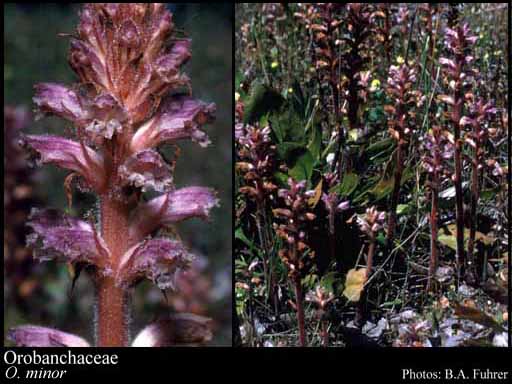- Reference
- Tabl.Regn.Vég. 2:292 (1799)
- Name Status
- Current







Scientific Description
Common name. Broomrape Family.
Habit and leaf form. Achlorophyllous herbs. More or less ‘normal’ plants. Leaves much reduced. Plants more or less succulent; more or less totally parasitic. On roots of the host. Plants with neither basal nor terminal concentrations of leaves. Mesophytic. Leaves small; alternate; spiral; membranous; sessile; non-sheathing; simple. Leaf blades entire; lanceolate, or oblong to ovate. Leaves without stipules. Leaf blade margins entire. Leaf anatomy. Hydathodes present (occasionally), or absent. Stem anatomy. Nodes unilacunar. Secondary thickening absent.
Reproductive type, pollination. Fertile flowers hermaphrodite. Unisexual flowers absent. Plants hermaphrodite. Entomophilous.
Inflorescence and flower features. Flowers aggregated in ‘inflorescences’; in racemes and in spikes. The terminal inflorescence unit racemose. Inflorescences terminal; usually spikes, rarely racemes. Flowers bracteate (one flower in the axil of each scale); small to medium-sized; very irregular. The floral asymmetry involving the perianth and involving the androecium. Flowers cyclic; tetracyclic. Free hypanthium absent. Hypogynous disk present (fleshy). Perianth with distinct calyx and corolla; (6–)8, or 10; 2 -whorled; isomerous (usually), or anisomerous. Calyx 4–5 (fid), or 2 (the four sepals sometimes more or less united into a lateral pair); 1 -whorled; gamosepalous; blunt-lobed, or toothed (or variously split); valvate, or open in bud; unequal but not bilabiate, or bilabiate; persistent. Corolla 5; 1 -whorled; gamopetalous (the tube often curved); imbricate (the adaxial members internal); unequal but not bilabiate to bilabiate; persistent. Androecium 4, or 5. Androecial members adnate (epipetalous); markedly unequal; free of one another; 1 -whorled. Androecium exclusively of fertile stamens, or including staminodes. Staminodes when present, 1. Stamens 4; didynamous; reduced in number relative to the adjacent perianth (the posterior androecial member being absent or staminodal); oppositisepalous; all alternating with the corolla members. Anthers cohering, or separate from one another; dorsifixed; dehiscing via longitudinal slits; introrse; unilocular to bilocular; tetrasporangiate; appendaged (the connective sometimes spurred at the top), or unappendaged. Gynoecium 2 carpelled (usually), or 3 carpelled. The pistil 1 celled. Carpels reduced in number relative to the perianth. Gynoecium syncarpous; synstylovarious, or eu-syncarpous; superior. Ovary unilocular; 1 locular. Gynoecium usually median. The ‘odd’ carpel (when G3) posterior. Gynoecium stylate. Styles 1; attenuate from the ovary; apical. Stigmas 2–4 - lobed; dry type; papillate; Group II type. Placentation parietal (the placentas sometimes branched). Ovules in the single cavity 12–100 (‘many’); non-arillate; anatropous.
Fruit and seed features. Fruit non-fleshy; dehiscent; a capsule. Capsules loculicidal, or valvular. Fruit 12–100 seeded (‘many’). Seeds endospermic. Endosperm oily. Seeds minute; with starch. Embryo rudimentary at the time of seed release; achlorophyllous (1/1). Seedling. Germination cryptocotylar.
Physiology, biochemistry. Aluminium accumulation not found.
Geography, cytology, number of species. World distribution: cosmopolitan, except Eastern South America, Eastern Australia and New Zealand. X = 12, 18–21. 180 species.